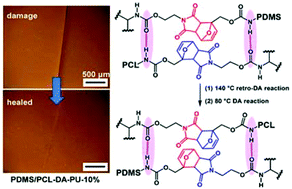Self-healing poly(siloxane-urethane) elastomers with remoldability, shape memory and biocompatibility†
Abstract
Thermally healable poly(siloxane-urethane) elastomers (PDMS-DA-PU and PDMS/PCL-DA-PU) with Diels–Alder (DA) bonds alternately located in the polymer chains between crosslinking points were prepared based on self-made soft segments, isocyanate terminated polydimethylsiloxane (NCO-PDMS-NCO) or a mixture of NCO-PDMS-NCO and polycaprolactone diol. The elastomers show good self-healing and remoldable behaviors via DA and retro-DA reactions, which was confirmed by UV-vis and 1H NMR. In order to enhance the mechanical properties, the PCL segment was introduced into the chain of poly(siloxane-urethane). The microphase separation structure and covalent crosslinked network endow the polymers with good tensile strength, elasticity and shape recovery ability. Moreover, the biocompatibility of the poly(siloxane-urethane) elastomer was found to be fairly good by cytotoxicity evaluation and animal wound healing experiments, suggesting its potential application in biomedical fields such as artificial skin with a self-healing function.


 Please wait while we load your content...
Please wait while we load your content...